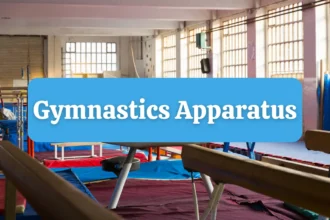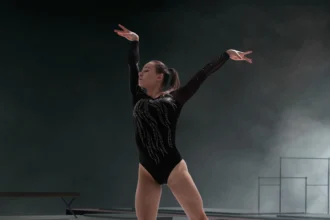When you look at gymnasts, particularly those who specialize in the rings, you may notice their arms are significantly more muscular compared to many calisthenics athletes. This phenomenon has sparked various theories about why gymnasts tend to have larger, more defined biceps.
While calisthenics athletes certainly build impressive upper body strength, gymnasts seem to have a unique advantage when it comes to arm development. Let’s break down the reasons behind this difference.
1. Straight Arm Strength
A key factor that contributes to gymnasts’ bigger arms is the incredible emphasis on straight-arm strength.
In gymnastics, moves like the Iron Cross, Maltese, and Plange require gymnasts to hold their bodies in specific positions with their arms fully extended. The more you stretch your arms in these movements, the more stress is placed on your biceps and other upper body muscles.
Gymnastics exercises like the Maltese, Iron Cross, and Planche require holding positions where the arms are fully extended, which places significant stress on the biceps. When gymnasts perform these moves, the leverage increases the intensity of the exercise, making it much harder on their arms than simpler, tucked versions of the same movements.
For comparison, consider a simpler movement like a tucked planche, where the arms are not fully extended. In this position, the biceps are not under as much strain, since the arms are bent and the body is in a more compact form.
The leverage in the tucked position is much easier on the arms compared to the extended positions of moves like the Maltese. Therefore, gymnasts who regularly perform these full-extension moves develop much stronger biceps and forearms than athletes who focus on exercises with less arm extension.
2. Dynamic Motion vs. Static Holds
Another key difference between gymnasts and calisthenics athletes that contributes to the former’s larger arm muscles is the way they incorporate dynamic motion into their training versus the more static holds often seen in calisthenics.
Gymnastics: Moving Through Dynamic Ranges of Motion
In gymnastics, exercises like ring routines or parallel bar routines involve transitioning through multiple positions, requiring constant motion. These dynamic movements force the arms to continuously engage and stabilize as the gymnast flows from one position to another.
For instance, during a ring routine, a gymnast may begin in a strength position like the Iron Cross (with arms fully extended) and then transition into more fluid motions, such as swinging or twisting. Each transition requires the arms to actively stabilize and control the body, forcing them to work through multiple angles and exert greater force.
These dynamic movements result in a broader range of muscle activation. The muscles are engaged in different ways at various points throughout the movement, allowing for more complete muscle development.
Calisthenics: Focus on Static Holds
On the other hand, calisthenics often focuses on static holds or isometric exercises. Movements like the planche, front lever, or L-sit require athletes to hold a position for an extended period, building strength through maintaining the hold rather than moving through a dynamic range. While these exercises do require strength and muscle endurance, they don’t engage the muscles in as many ways as gymnastics routines do.
For example, a tucked planche requires the athlete to maintain a position where the arms are working to stabilize the body, but they’re generally in a fixed position. While the biceps and shoulders are certainly activated, they are not pushed through a variety of motions as they would be in a gymnastics routine. The arms work more to hold the position, rather than dynamically adjusting through a full range of motion.
Why Dynamic Motion Leads to Bigger Arms
As the gymnast moves through different positions, their arms are required to stabilize and adjust, which leads to more muscle fiber activation. The constant engagement and varying angles of force result in greater hypertrophy over time, particularly in the biceps, shoulders, and forearms.
Additionally, because gymnasts often perform complex skills at high speeds, the explosive nature of many of their movements (such as a sudden push-off or pull-up during a rings routine) engages more fast-twitch fibers, which grow larger and stronger than slow-twitch fibers typically used in static holds.
Calisthenics athletes, while still developing impressive strength and muscle tone, generally do not engage their muscles through as wide a range of motions or with the same explosive force. This results in somewhat less muscle development, particularly in the arms and shoulders.
3. Supinated Hand Position
Another important factor contributing to the larger arm size in gymnasts compared to calisthenics athletes is the hand position used during many gymnastics movements. Specifically, gymnasts often perform exercises with their hands in a supinated position (palms facing up or outward), which places more emphasis on the biceps and forearms.
Gymnastics: Supinated Hand Position for Maximum Bicep Activation
In gymnastics, particularly on the rings, athletes often perform movements with a supinated or semi-supinated grip. This hand position dramatically increases the involvement of the biceps during exercises like the Iron Cross, Maltese, and planche variations.
For example:
- In the Iron Cross on rings, the gymnast’s arms are fully extended with palms facing outward. This supinated grip forces the biceps to bear more of the load, providing a deep stretch and creating more tension in the biceps than when using a neutral or pronated grip.
- In exercises like the Maltese or straddle planche, the hands are often positioned in such a way that the biceps are engaged in a flexed, supinated position. This hand orientation forces the biceps to work harder to stabilize the body, since the leverage shifts toward the arms, particularly the upper arms and forearms.
The supinated hand position creates more tension in the biceps because of the biomechanics involved. When the hands are supinated, the biceps have to contract more powerfully to maintain the position and stabilize the body. In essence, this hand position makes the arms function almost like they are performing a continuous bicep curl throughout the movement.
Calisthenics: Neutral Hand Position
In contrast, calisthenics athletes often perform exercises with a neutral grip (palms facing each other) or a pronated grip (palms facing downward). This means that while the biceps are still engaged, they don’t receive the same level of direct tension as they do in gymnastics movements where the hands are supinated.
For example:
- In a push-up or pull-up (common calisthenics exercises), the grip is often either neutral or pronated. In these positions, the biceps are involved in assisting the movement, but the tension on the biceps is less intense compared to exercises where the palms are facing outward or up.
- In exercises like dips or chin-ups, which also involve arm strength, the hand position is usually neutral or pronated, with the biceps acting as secondary movers, while the triceps and shoulders tend to take the primary load.
Why Supinated Hand Position Matters for Arm Growth
The supinated hand position in gymnastics forces the arms, particularly the biceps, to bear more of the weight during many key movements. When the palms are facing up, the body mechanics change, and the biceps are recruited to stabilize and support the body in a way that isn’t as pronounced in calisthenics exercises. This additional engagement in a lengthened and contracted position allows for greater hypertrophy, or muscle growth, in the biceps and forearms over time.
Moreover, the instability of the rings adds challenge. Since the rings are not fixed, the gymnast must continuously adjust their hand and arm position to maintain balance and stability. This added requirement for stabilization works the smaller stabilizing muscles in the forearms and biceps, further enhancing muscle development.
4. Training Methodology
The way gymnasts and calisthenics athletes train is a key factor in how their arms develop. Here’s how these different training approaches affect arm development:
Gymnasts: High-Intensity, Skill-Based Movements
Gymnasts train with exercises that put significant strain on their arms, especially the biceps, shoulders, and forearms. These movements demand dynamic strength and explosive power, often with the arms fully extended or in challenging angles.
Here’s how gymnastics training impacts arm development:
- Progressive Skill Mastery: Gymnasts don’t stick to basic variations of exercises. Instead, they progress directly to harder moves with the help of specialized equipment like rings and bars.
- Dynamic Movements with Full Range of Motion: Gymnastics routines involve fast, explosive movements with various arm angles. These routines work the arms through a full range of motion, developing both strength and endurance.
- Straight Arm Strength: A unique aspect of gymnastics is its focus on straight-arm strength, especially on the rings. These straight-arm movements are much more demanding than the typical bent-arm exercises used in calisthenics.
Calisthenics: Generalized Strength and Mastery
Calisthenics athletes also focus on bodyweight exercises, but their training is different from gymnastics. These exercises are excellent for building strength but don’t place as much strain on the arms as gymnastics movements.
Here’s how calisthenics training affects arm development:
- Static Holds: Many calisthenics athletes start with static holds like the tucked planche or L-sit. While valuable for building core strength and endurance, these exercises don’t challenge the arms as intensely as gymnastics moves.
- Linear Progression: In calisthenics, athletes follow a gradual progression—starting with easier exercises and moving on to harder ones. While this method builds strength, it doesn’t place the same level of intensity on the muscles as the movements in gymnastics.
- Less Dynamic Movement: Calisthenics exercises focus more on repetition and strength in basic movements like pull-ups and dips. These exercises are great for building baseline strength but don’t provide the explosive, full-body challenge that gymnastics routines do.
- Bent Arm Strength: Most calisthenics exercises involve bent-arm strength (e.g., push-ups, pull-ups), which helps build arm muscles. However, it doesn’t target the arms as intensely as straight-arm exercises in gymnastics.
The Bottom Line
Ultimately, the differences in training methodology, movement complexity, and muscle engagement are the primary reasons why gymnasts tend to develop larger, more muscular arms than their calisthenics counterparts.




